Publications
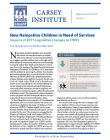
December 10, 2013
Using administrative data from state and local agencies and data from interviews with CHINS professionals, this brief provides an overview of participation in the Children in Need of Services (CHINS) program before and after the change in the law in September 2011 but before funding returned in 2013.
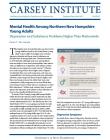
November 13, 2013
This brief uses data on depressive and substance abuse symptoms from two surveys administered in 2011—the Coös Youth Study and the National Survey on Drug Use and Health—to compare mental health patterns among young adults in Coös County, New Hampshire, to patterns among rural young adults nationwide.
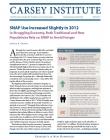
November 5, 2013
This brief uses data from the American Community Survey to examine rates of Supplemental Nutrition Assistance Program (SNAP) receipt in 2012, track changes since the onset of the recession, and monitor receipt by region and place type.
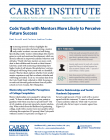
October 1, 2013
This fact sheet explores whether Coös youths’ mentor experiences and their academic attitudes and well-being are linked. Authors Kent Scovill and Corinna Jenkins Tucker analyze data from the Coös Youth Study collected in 2008, focusing on seventh and eleventh grade students from all public schools in Coös County, New Hampshire.
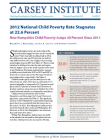
September 20, 2013
In this brief, authors Marybeth Mattingly, Jessica Carson, and Andrew Schaefer use American Community Survey data released on September 19, 2012, to explore patterns of child poverty across states and place types, focusing on changes both since 2011 and since the recession began in 2007.
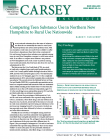
July 30, 2013
Using data administered in 2011 from the Carsey Institute’s Coös Youth Study and the National Survey on Drug Use and Health, this brief compares teen substance use patterns in New Hampshire’s most rural county to patterns among rural youth nationwide.
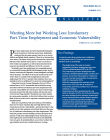
July 23, 2013
Using data from the Current Population Survey, a national survey of U.S. households, this brief outlines a strong association between involuntary part-time employment and economic vulnerability. Author Rebecca Glauber reports that the involuntary part-time employment rate more than doubled between 2007 and 2012.
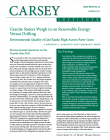
July 16, 2013
Since the fall of 2001, the University of New Hampshire’s Survey Center has been conducting the Granite State Poll—a statewide, scientific survey of public opinion and behavior concerning policy issues—via telephone interviews with random samples of New Hampshire residents about four times each year.
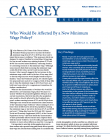
June 18, 2013
This brief describes the population who would be directly affected by the President’s proposal to increase the minimum wage to $9.00 per hour: workers earning between $7.25 and $9.00 per hour.
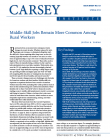
June 11, 2013
This issue brief uses data from the Current Population Survey collected from 2003 to 2012 to assess trends in employment in middle-skill jobs and the Great Recession’s impact on middle-skill workers, with particular attention paid to differences between those in rural and urban places.
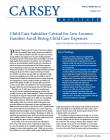
May 21, 2013
The high cost of child care is a barrier to employment among low-income families with young children. Child care subsidies are designed to support both parental employment and child development by lowering the cost of child care and making high-quality child care affordable to low-income families.
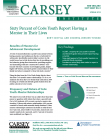
May 7, 2013
In this brief, authors Kent Scovill and Corinna Jenkins Tucker describe Coös youths’ mentor relationships using data from the Carsey Institute’s Coös Youth Study collected in 2007. They report that, in 2007, a majority of Coös youth in seventh and eleventh grade (60.2 percent) report having a mentor.

April 23, 2013
The purpose of the Going Places deliberations was to engage people in a constructive conversation about the transportation system in New Hampshire and begin to identify priorities and key areas for improvements. What follows is a detailed description of the process, outcomes of the conversations, and an analysis of all small group reports that identify areas for further consideration and action…

April 17, 2013
The 2012 New Hampshire Civic Health Index follows earlier studies, including the New Hampshire Civic Index compiled by the NH Institute of Politics at Saint Anselm College in 2006 and the 2009 Civic Health Index published by the Carsey Institute in collaboration with the National Conference on Citizenship and Knowledge Networks.
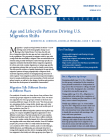
April 12, 2013
Migration—people moving between locations—is now driving much of the demographic change occurring in the United States. In this brief, authors Kenneth Johnson, Richelle Winkler, and Luke Rogers share new research on age-related migration patterns to provide a fuller understanding of the complex patterns of demographic change in the United States.

April 5, 2013
This executive summary provides an overview of the process and results of an extended public engagement process conducted by New Hampshire Listens of the Carsey Institute at the
University of New Hampshire and the University of New Hampshire Cooperative Extension, on behalf of the nine Regional Planning Commissions (RPCs) in New Hampshire. The work was carried out under contract with the Nashua…
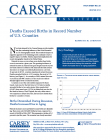
March 14, 2013
In this fact sheet, author Kenneth Johnson examines new data released by the Census Bureau which provide insights into the continuing influence of the Great Recession on U.S. demographic trends. He reports that, for the first time in U.S. history, deaths exceeded births in two entire states: Maine and West Virginia, and a record 36 percent of all U.S.
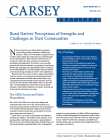
February 26, 2013
This brief uses two sources of data to explore how Native Americans view the current socioeconomic and environmental state of their communities and their future within them—the Community and Environment in Rural America (CERA) surveys and focus groups with Native leaders in one rural state.
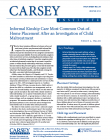
February 12, 2013
This fact sheet examines differences between urban and rural areas in foster care placement with informal kin caregivers. The data for this analysis come from a national sample of children who had a maltreatment report that resulted in an investigation: the second National Survey of Child and Adolescent Well-Being.
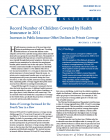
February 5, 2013
Using data from the 2008 through 2011 American Community Survey, this brief describes rates of children’s health insurance coverage nationally, by region, and place type (that is, rural, suburban, and central city). In addition, it details the composition of coverage in the United States, specifically the proportion of children covered by private and public insurance.
